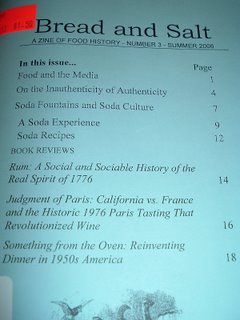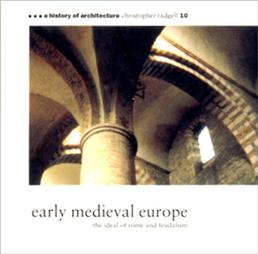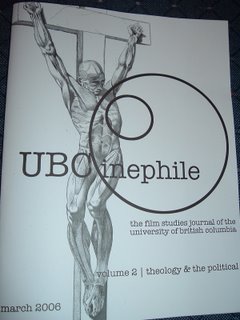
Bread and Salt: A Zine of Food History
Number 3 - Summer 2006
The brainchild of Tim Miller, Bread and Salt is one of the most readable, thoughtful zines I've ever stumbled across. Unassumingly bound inside a sheet of blue paper, it combines thoughtful criticism and history with fascinating illustrative material of food and food preparation throughout time. Putting substance above style (many zines take the other approach, sometimes to their credit but often not), Bread and Salt brings wit to food's interesting past.
This issue kicks off with an editorial of sorts that bemoans how food is handled in and by the mass media. He has a big gripe with the food channel's total privileging of Italian cuisine at the expense of all others, and rightfully so. While Italian food has a vast cultural capital (one can almost instantly understand Roland Barthes' use of "Italianicity" in examining the semiological meaning of an Italian food advertisement), it seems to have peaked in popularity. People speak of loving the ambiance, tastes, and experiences of Ethiopian, Lebanese, and Indian restaurants, yet few who did not grow up in those national traditions dare to try making these foods for themselves. I find his criticisms of food culture at large to be refreshing.
Miller writes a brief bit about "Authenticity," a very contested idea for the gastronomically-minded. We all "remember" how good our Grandmother's cookies were as a child...30 years down the road, we desperately claw to find that lost bit of reality. Miller suggests that, while the food of out past might have tasted very yummy, we often over-imagine its worth in memory and thus grapple with whether or not it really tasted that good to begin with. As a little thought exercise, just imagine the foods of your youth that you no longer have access to, but then really question if you are simply making a Romantic overvaluation. 9 times out of 10 I think I do.
The "meat and potatoes" of this issue of the zine is an exploration of Soda Fountains. Using a Prohibition-era book called The Dispenser's Formulary as a launch pad, it delves into the thriving icon of the Soda Fountain. Miller reveals that milkshakes, ice creams, and other treats used to be made with different ingredients and for a crowd with differing expectations. Eye-opening recipes accompany.
Last up are book reviews: Miller brings an expert's eye to Rum: A Social and Sociable History of the Real Spirit of 1776, Judgment of Paris: California vs. France and this Historic 1976 Paris Tasting that Revolutionized Wine, and Something from the Oven: Reinventing Dinner in 1950s America.
Recommended! Visit http://whammyindustries.com for more!
The MacArthur Foundation recognizes this cruel reality but does something about it. One cannot simply apply to be a MacArthur Fellow - one is chosen by a secret constituency of peers. A MacArthur fellowship is designed to let the avowed movers and shakers of the world do their moving and shaking. A generous sum of $500,000 is paid out, quarterly, over five years. Freed from any financial and institutional obligations (most bosses will gladly let a MacArthur Fellow take off as much time as they need, since their status as a fellow greatly increases their value to the institution), these lucky persons can develop their skills as best they see fit.
This fellowship is often (though the foundation claims, unfairly) called a "genius grant." Despite protests to the contrary, these men and women are geniuses. A brief survey of past fellows reveals just that.
In fiction writing: Ernest J. Gaines, Thomas Pynchon, David Foster Wallace. In music: Ornette Coleman, Ali Akbar Khan, Cecil Taylor, John Zorn. In photography/film: Lee Friedlander, Errol Morris, John Sayles, Bill Viola. In poetry: Alice Fulton, Edward Hirsch, Robert Penn Warren.
In the visual arts: David Macaulay, James Turrell, Cindy Sherman. Beyond that, there are long lists of winners in the humanities, social sciences, and hard sciences. The names in these fields are equally illustrious.
Anyone care to nominate me?
Whereunto (in your opinion) doth this little flourish of a preamble tend?
For so much as you, my good disciples, and some other jolly fools of ease
and leisure, reading the pleasant titles of some books of our invention, as
Gargantua, Pantagruel, Whippot (Fessepinte.), the Dignity of Codpieces, of
Pease and Bacon with a Commentary, &c., are too ready to judge that there
is nothing in them but jests, mockeries, lascivious discourse, and
recreative lies; because the outside (which is the title) is usually,
without any farther inquiry, entertained with scoffing and derision. But
truly it is very unbeseeming to make so slight account of the works of men,
seeing yourselves avouch that it is not the habit makes the monk, many
being monasterially accoutred, who inwardly are nothing less than monachal,
and that there are of those that wear Spanish capes, who have but little of
the valour of Spaniards in them. Therefore is it, that you must open the
book, and seriously consider of the matter treated in it. Then shall you
find that it containeth things of far higher value than the box did
promise; that is to say, that the subject thereof is not so foolish as by
the title at the first sight it would appear to be.
- Francois Rabelais, from the introduction to Gargantua

A History of Architecture, Volume 10
Christopher Tadgell
Early Medieval Europe: The Ideal of
Ellipsis Books, 2001
$15.00
Christopher Tadgell's fascinating "A History of Architecture" series never quite made it (from what I can tell). Originally projected as a 25 book set that traced the history of buildings from the earliest civilizations to the most post of postmodernism, it pretty much stopped at volume 10 or 11. What exists is a worthy fragment.
Ellipsis books of
Tadgell's style is precise, if inundated by technical terms, and rides a wobbly rail between academic and accessible. The books themselves are brilliantly designed - at only about 2.5 inches square, they are the most portable architecture books in the world (compare to the Phaidon Atlas of World Architecture, which is nearly two feet tall). The photographs are of remarkable enough quality to do justice in the format.
Early Medieval Europe provides a groundwork of social, material and historical substance to the building of the years in question. With the exception of the technical passages, the book could serve as an excellent introduction to the general historical reality of the world at that time. Tadgell organizes by geography and époque, showing how the last vestiges of
With the exception of a few layout errors (passages are cut-off or disappear entirely), this is recommended reading for newcomers and veterans alike.
- Victor Burgin

UBCinephile: The Film Studies Journal of the
Volume 2: Theology & the Political (March 2006)
This is not strictly a zine, per se: UBCinephile is styled as an academic, peer-reviewed film journal. From what I can tell, it is produced once a year and resembles the DIY aesthetic of most zines, albeit with strictly scholarly content. Before examining it too closely, I’d like to throw a certain amount of support behind it: edited by graduate students and providing space for undergraduate writings, it could be an invaluable resource for a student’s first forays into writing. While it is archived online, its existence as a print artifact makes its goals more alluring.
That said, the theme of the issue “Theology & the Political” is a bit of an after-the-fact moniker. Editor Christine Evans posits a bold program of intent: “It is therefore the aim of this issue of UBCinephile to accept both theology and the political as coercive and reciprocal objects rooted and comprehended in the realm of the symbolic: if all theology is inherently political and all politics essentially theological, how does the idea of theology manifest in the current cultural sphere?” There are no “theory of everything articles” here, but rather a newer breed of academic film writing (I noticed its prevalence at the Society for Cinema and Media Studies conference in
Taking popular cinema seriously is a valuable, often maligned, practice, so R. Colin Tait’s piece on I (Heart) Huckabees and David Hucka’s work on The Passion of the Christ (sure to be one of the most often written-about movies of the next ten years) deserve time. Given my interests, the most engaging essay is “Metamorphic Death: Post-Mortem & Spirit Photography in Narrative Cinema” by Katherine Pettit. Those Victorians, as we know, had a strange attraction to capturing real/metaphorical/suggestive death via photographs, a practice which continues in some recent cinema.
Rounding out the zine are some fine book reviews that provide pungent assessments of some major works by bigwigs like Jean Baudrillard and Fredric Jameson. One must have a stomach for heady stuff before tackling the writing of this particular iteration of UBCinephile, but it is worthwhile stuff. If you cannot find a print copy (and few outside of



